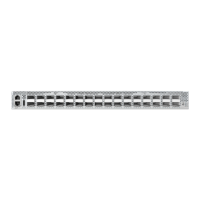C
HAPTER
20
| Unicast Routing
Configuring the Open Shortest Path First Protocol (Version 2)
– 514 –
CLI REFERENCES
◆ "router ospf" on page 1043
◆ "area default-cost" on page 1048
◆ "area nssa" on page 1054
COMMAND USAGE
◆ Before creating an NSSA, first specify the address range for the area
(see "Defining Network Areas Based on Addresses" on page 504). Then
create an NSSA as described under "Adding an NSSA or Stub" on
page 512.
◆ NSSAs cannot be used as a transit area, and should therefore be placed
at the edge of the routing domain.
◆ An NSSA can have multiple ABRs or exit points. However, all of the exit
points and local routers must contain the same external routing data so
that the exit point does not need to be determined for each external
destination.
◆ There are no external routes in an OSPF stub area, so routes cannot be
redistributed from another protocol into a stub area. On the other
hand, an NSSA allows external routes from another protocol to be
redistributed into its own area, and then leaked to adjacent areas.
◆ Routes that can be advertised with NSSA external LSAs include network
destinations outside the AS learned through OSPF, the default route,
static routes, routes derived from other routing protocols such as RIP,
or directly connected networks that are not running OSPF.
◆ An NSSA can be used to simplify administration when connecting a
central site using OSPF to a remote site that is using a different routing
protocol. OSPF can be easily extended to cover the remote connection
by defining the area between the central router and the remote router
as an NSSA.
PARAMETERS
These parameters are displayed in the web interface:
◆ Process ID – Process ID as configured in the Network Area
configuration screen (see page 504).
◆ Area ID – Identifier for a not-so-stubby area (NSSA).
◆ Translator Role – Indicates NSSA-ABR translator role for converting
Type 7 external LSAs into Type 5 external LSAs. These roles include:
■
Never – A router that never translates NSSA LSAs to Type-5
external LSAs.
■
Always – A router that always translates NSSA LSA to Type-5
external LSA.
■
Candidate – A router translates NSSA LSAs to Type-5 external
LSAs if elected.

